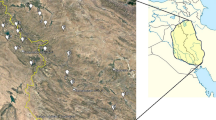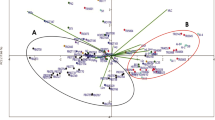Abstract
We evaluated morphological, isozyme and biochemical diversity of a total of 87 accessions in the genus Camellia [Camellia sinensis var. sinensis (10), C. talinensis (7), C. sinensis var. dehungensis (3), C. crassicolumna (3) and C. sinensis var. assamica (64)]. Great variation of morphological characters was apparent within each taxa. Across the five taxa, all leaf and most flower quantitative characters showed significant differences while all fruit quantitative characters measured did not differ significantly, and, seven (i.e., life form, bud color, petal texture, pubescence on ovary, style number, stamen location and locule per fruit) of the 33 qualitative characters yield significant differences. As a whole, caffeine content had the highest variation with CV of 22.7%, water extract solid showed the least variation (13.4%) and content of polyphenols (20.0%) and free amino acids (18.8%) showed intermediate variations. Camellia taliensis and C. sinensis var. assamica had significantly higher content of polyphenols and water extract solid than in the other three taxa, while no significant differences were detected for the content of caffeine and free amino acids. For allozyme study, 14 loci presented good resolution, among which, nine loci (64%) were polymorphic in each taxon (AAT-3, FUM-1, 6PDG-1, G6PDH-1, G3PDH-1, ME-1, PGM-1, PGM-2 and SKD-1). The percentage of polymorphic loci (P) for each taxon was 21.4–50.0%. Mean heterozygosity per locus (H e ) varied 0.114–0.218. F ST value indicated that only 4.6% of the variations could be ascribable to genetic differences among taxa. Genetic relationships among the five taxa revealed by allozymes, were also exposed by the result of clustering of the morphological and biochemical characters.
Similar content being viewed by others
References
Banerjee B. 1992. Botanical classification of tea. In: Wilson K.C. and Clifford M.N. (eds), Tea: Cultivation to Consumption, Chapman and Hall, London, pp. 25–51.
Chang H.T. and Bartholomew B. 1984. Camellia. B.T. Batsford, London.
Chen X.Y. 1994. The Original Locality of Tea Plant. Yunnan People’s Press, Kunming Yunnan, China (in Chinese).
Doebley J. 1989. Isozymic evidence and the evolution of crop plants. In: Soltis D.E. and Soltis P.S. (eds), Isozymes in Plant Biology, Dioscorides, Portland, OR, pp. 165–191.
Du Q.Z., Li M.J. and Liu W.H. 1990. Chemical and numerical taxonomies of plants Thea section plants. J. Tea Sci. 10: 1–12 (in Chinese with English abstract).
Evans J.C. 1992. Tea in China. Greenwood Press, 88 Post Road West, Westport, pp. 1–22.
Hebert P.D.N. and Beaton M.J. 1993. Methodologies for Allozyme Analysis using Cellulose Acetate Electrophoresis: A practical Handbook. (An educational service of Helena Laboratories).
Ikeda N., Kawada M. and Takeda Y. 1991. Isozymic analysis of Camellia sinensis and its interspecific hybrids. In: Proceedings of the International Symposium of Tea Science, held at Shizouka, Japan, 26–28 August 1991, pp. 98 (Abstract).
Kaundun S.S. and Park Y.G. 2002. Genetic structure of six Korean tea populations as revealed by RAPD-PCR markers. Crop Sci. 42: 594–601.
Kaundun S.S., Zhyvoloup A. and Park Y.G. 2000. Evaluation of the genetic diversity among elite tea (Camellia sinensis var. sinensis) accessions using RAPD markers. Euphytica 115: 7–16.
Lai J.A., Yang W.C. and Hsiao J.Y. 2001. An assessment of genetic relationships in cultivated tea clones and native wild tea in Taiwan using RAPD and ISSR maskers. Bot. Bull. Acad. Sinica 42: 93–100.
Lee S.H., Choi H.S., Kim R.S., Lee H.Y. and Nou I.S. 1995. Identification of Korean wild tea plants and Japanese green tea cultivars using RAPD markers. J. Korean Tea Sci. 1: 129–148.
Levin D.A. 2002. Hybridization and extinction. Am. Sci. 90: 254–261.
Li H.L. 1983. The domestication of plants in China: ecogeographical considerations. In: Keightley D.N. (ed.), The Origins of Chinese Civilization, University of California Press.
Lu C.Y., Liu W.H. and Li M.J. 1992. Relationship between the evolutionary relatives and the variation of esterase isozymes in tea plant. J. Tea Sci. 12: 15–20 (in Chinese with English abstract).
Magoma G.N., Wachira F.N., Obanda M., Imbuga M. and Agong S.G. 2000. The use of catechins as biochemical markers in diversity studies of tea (Camellia sinensis). Genet. Resour. Crop Evol. 47: 107–114.
Matsumoto S., Takeuchi A., Hayatsu M. and Kondo S. 1994. Molecular cloning of phenylalanine ammonia lyase cDNA and classification of varieties and cultivars of tea plants (Camellia sinensis) using the tea PAL cDNA probe. Theor. Appl. Genet. 89: 671–675.
Ming T.L. 2000. Monograph of the Genus Camellia. Yunnan Science and Technology Press, Kunming, Yunnan, China, pp. 110–135 (in Chinese with English abstract).
Nei M. 1978. Estimation of average heterozygosity and genetic distance from a small number of indivisuals. Genetics 89: 583–590.
Paul S., Wachira F.N., Powell W. and Waugh R. 1997. Diversity and genetic differentiation among populations of Indian and Kenyan tea (Camellia sinensis (L.) O. Kuntze) revealed by AFLP markers. Theor. Appl. Genet. 94: 255–263.
Sao W.F. and Sheng P.H. 1993. The brief history and characteristic of Pu’er Tea in Yunnan province. Chinese Agr. Archaeol. (supplement issue for Chinese tea culture), 50–54 (in Chinese).
Sealy J. 1958. A Revision of the Genus Camellia. Royal Horticultural Society, London.
Song W.X. and Li D.P. 1990. Din Hai Yu Heng Zhi Jiao Zhu. Yunnan People’s Press, Kunming, Yunnan, China (in Chinese).
Swofford D.L. and Selander R.B. 1989. BIOSYS-1: a computer program for the analysis of allelic variation in population genetics and biochemical systematics. Illinois Natural History Survey, Champaign, IL, USA.
Takeda Y. 1990. Cross compatibility of tea (Camellia sinensis) and its allied species in the genus Camellia. Jpn. Agrric. Res. Q. 24: 111–116.
Takeda Y. 1994. Differences in caffeine and tannin contents between tea cultivars and application to tea breeding. Jpn. Agric. Res. Q. 28: 117–123.
Toyao T. and Takeda Y. 1999. Studies on geographical diversity of floral morphology of tea plant (Camellia sinensis (L.) O. Kuntze) using the method of numerical taxonomy. Tea Res. J. 87: 39–57.
TLPMBand ITP (Tea and Livestock Products Management Bureau and Institute of Tea Processing, the Ministry of Commerce), 1989. The Physiochemical Analysis of Tea. Shanghai Science and Technology Press, Shanghai, China (in Chinese).
Ukers W.H. 1935. All About Tea. Tea and Coffee Trade Journals, New York.
Wachira F., Tanaka J. and Takeda Y. 2001. Genetic variation and differentiation in tea (Camellia sinensis) germplasm revealed by RAPD and AFLP variation. J. Hortic. Sci. Bio. Tech. 76: 557–563.
Wachira F., Wauch R., Hachett C.A. and Powell W. 1995. Detection of genetic diversity in tea (Camellia sinensis) using RAPD markers. Genome 38: 201–210.
Wachira F.N., Powell W. and Waugh R. 1997. An assessment of genetic diversity among Camellia sinensis L. (cultivated tea) and its wild relatives based on randomly amplified polymorphic DNA and organelle specific STS. Heredity 78: 603–611.
Weatherstone J. 1992. Historical introduction. In: Willson K.C. and Clifford M.N. (eds), Tea: Cultivation to Consumption, Chapman and Hall, London.
Weeden N.F. and Wendel J.F. 1989. Genetics of plant isozymes. In: Soltis D.E. and Soltis P.S. (eds), Isozymes in Plant Biology, Dioscorides Press, Portland, OR, pp. 46–72.
Wichremaratne M.R. 1981. Variation in some leaf characteristics in tea (Camellia sinensis L.) and their use in the identification of clones. Tea Q. 50: 183–189.
Wright S. 1978. Evolution and the Genetics of Populations, vol. 4, Variability Within and Among Natural Populations. University of Chicago Press, Chicago, IL.
Wright W. and Gilchrist R.C.J.H. 1961. The concept of kind of tea. Nature 191: 14–16.
Xiang D. 1962. Man Shu Jiao Zhu. Zhong Hua Shu Ju, Beijing, China (in Chinese).
Yunnan Statistic Bureau, 2000. Yunnan Annual Statistic Report. China Statistic Press, Beijing, China, 222 pp. (in Chinese).
Zeng Y.W., Wang J.J., Yang Z.Y., Shen S.Q., Wu L.H., Chen X.Y. and Meng J.G. 2001. The diversity and sustainable development of crop genetic resources in the Lancang River Valley. Genet. Resour. Crop Evol. 48: 297–306.
Author information
Authors and Affiliations
Corresponding author
Rights and permissions
About this article
Cite this article
Chen, J., Wang, P., Xia, Y. et al. Genetic diversity and differentiation of Camellia sinensis L. (cultivated tea) and its wild relatives in Yunnan province of China, revealed by morphology, biochemistry and allozyme studies. Genet Resour Crop Evol 52, 41–52 (2005). https://doi.org/10.1007/s10722-005-0285-1
Received:
Accepted:
Issue Date:
DOI: https://doi.org/10.1007/s10722-005-0285-1




